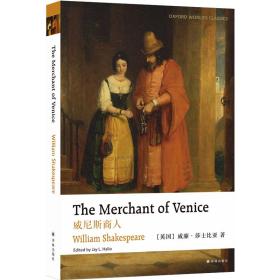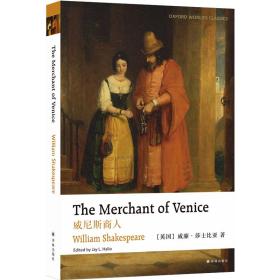
牛津英文经典:威尼斯商人
批量上传,套装书可能不全,下单前咨询在线客服!有特殊要求,下单前请咨询客服!
¥ 11.09 3.5折 ¥ 32 全新
库存13件
作者威廉·莎士比亚 著
出版社译林出版社
ISBN9787544783088
出版时间2020-08
装帧平装
开本16开
定价32元
货号29002737
上书时间2024-11-03
- 最新上架
商品详情
- 品相描述:全新
- 商品描述
-
导语摘要
威尼斯青年巴萨尼奥为了向富有的鲍西娅求婚,向朋友安东尼奥借款。由于安东尼奥的资金都投在了海上的货物,只好向高利贷商人夏洛克借钱。夏洛克长期不满安东尼奥,于是在借款条约中规定如果安东尼奥不能按时还款,则要从他身上割下一磅肉。巴萨尼奥求婚顺利,但是安东尼奥却无力还款,即将面临生命危险。于是,鲍西娅乔装为律师,用精彩的辩护为他们解了围。
“牛津英文经典”版本《威尼斯商人》的编者、导读撰写者为莎剧研究专家、美国特拉华大学英语系教授杰伊?L.哈利奥,文字版本从现存各版本中精选加工,采用现代英语拼写断句,每一页均附有词汇、内容解析,拥有完整索引可查,是适合学生、演员和大众读者的优良版本。
作者简介威廉·莎士比亚(1564—1616),英国文艺复兴时期伟大的剧作家、诗人,欧洲文艺复兴时期人文主义文学的集大成者,全世界卓越的文学家之一。英国戏剧家本·琼森称他为“时代的灵魂”,马克思称他与古希腊的埃斯库罗斯为“人类伟大的戏剧天才”。
莎士比亚流传下来的作品包括38部剧本、154首十四行诗、两首长叙事诗和其他诗作。其中代表作主要为诗剧:《李尔王》《哈姆莱特》《奥赛罗》《罗密欧与朱丽叶》《威尼斯商人》等。他的作品是人文主义文学的杰出代表,在世界文学史上占有重要的地位。他的作品直至今日依旧广受欢迎,在全球以不同文化和政治形式演出和诠释。
目录Contents
List of Illustrations
General Introduction
Shakespeare and Semitism
Sources, Analogues, and Date
The Play
The Merchant of Venice in Performance
Textual Introduction
Editorial Procedures
Abbreviations and References
THE MERCHANT OF VENICE
APPENDIX
Speech prefixes for Shylock in Q1, Q2, and F
Index
内容摘要威尼斯青年巴萨尼奥为了向富有的鲍西娅求婚,向朋友安东尼奥借款。由于安东尼奥的资金都投在了海上的货物,只好向高利贷商人夏洛克借钱。夏洛克长期不满安东尼奥,于是在借款条约中规定如果安东尼奥不能按时还款,则要从他身上割下一磅肉。巴萨尼奥求婚顺利,但是安东尼奥却无力还款,即将面临生命危险。于是,鲍西娅乔装为律师,用精彩的辩护为他们解了围。
“牛津英文经典”版本《威尼斯商人》的编者、导读撰写者为莎剧研究专家、美国特拉华大学英语系教授杰伊?L.哈利奥,文字版本从现存各版本中精选加工,采用现代英语拼写断句,每一页均附有词汇、内容解析,拥有完整索引可查,是适合学生、演员和大众读者的优良版本。
主编推荐威廉·莎士比亚(1564—1616),英国文艺复兴时期伟大的剧作家、诗人,欧洲文艺复兴时期人文主义文学的集大成者,全世界卓越的文学家之一。英国戏剧家本·琼森称他为“时代的灵魂”,马克思称他与古希腊的埃斯库罗斯为“人类伟大的戏剧天才”。
莎士比亚流传下来的作品包括38部剧本、154首十四行诗、两首长叙事诗和其他诗作。其中代表作主要为诗剧:《李尔王》《哈姆莱特》《奥赛罗》《罗密欧与朱丽叶》《威尼斯商人》等。他的作品是人文主义文学的杰出代表,在世界文学史上占有重要的地位。他的作品直至今日依旧广受欢迎,在全球以不同文化和政治形式演出和诠释。
精彩内容General Introduction
ANY approach to understanding Shakespeare’s The Merchant of Venice inevitably includes a discussion of the vexed question of its alleged anti-Semitism. This Introduction to the play therefore confronts the question directly, focusing on the background against which the play must be considered and a comparison with another play famous, or infamous, for its portrayal of a Jew, Marlowe’s The Jew of Malta. From thence a discussion of the Merchant’s more immediate sources and its data continues, followed by a detailed analysis of the play itself, which emphasizes its ambiguities, inconsistencies, and internal contradictions. This discussion naturally leads into a survey of the play’s performance history, particularly its representation of the dominant character, Shylock, and the major ways he has been portrayed. The Introduction concludes with a discussion of the text and the editorial procedures followed in this edition.
Shakespeare and Semitism
Shakespeare’s attitude toward Jews, especially in The Merchant of Venice, has been the cause of unending controversy. Recognizing the problem, in the Stratford-upon-Avon season of 1987 the Royal Shakespeare Company performed The Merchant of Venice back-to-back with a production of Marlowe’s The Jew of Malta. The Jew of Malta, played as a very broad heroic comedy, was evidently intended to contrast with Shakespeare’s play and disarm criticism, such as the RSC had experienced earlier, in 1983, with a less successful production of The Merchant. To reinforce the strategy, Antony Sher, a South African Jew, was cast as Shylock. It almost worked, but not quite. Sher was largely a sympathetic Shylock, with swastikas and other anti-Semitic slurs used to underscore the money-lender as victim; however, the trail scene portrayed Shylock as extremely bloodthirsty. Interpolating some extra-Shakespearian stage business, borrowed from the Passover Haggadah, The RSC and Sher indicated that cutting Antonio’s pound of flesh was tantamount to a religious ritual of human sacrifice. Of course, nothing could be further from Jewish religious practice or principles, the aborted sacrifice of Isaac in Genesis 22 being the archetype of Jewish opposition to human sacrifice. In the event, Antony Sher’s Shylock was not far removed from Alun Armstrong’s Barabas.
Looking closely at both Marlowe’s play and Shakespeare’s will clarify the attitudes towards Semitism in those dramas, but the background against which both were conceived is also important. Jews had been officially banished from England since the Expulsion of 1290 by King Edward, but the eviction was not quite thoroughgoing as was hoped. A few Jews, whether converts or not, remained in England in the intervening period before Oliver Cromwell invited them to return in the seventeenth century. There is sufficient evidence for this assertion, but whether Shakespeare or Marlowe actually knew any Jews may be irrelevant. In their plays they wrote not from personal experience but from a tradition that had evolved both in England and on the Continent of the Jew as alien, usurer, member of a race maudite. In Marlowe’s case, the tradition of the amoral machiavel was even more important than that of the money-lender.
In these post-Holocaust days, it may be difficult for us to conceive how Jews were regarded and treated in Europe, including England, during the Middle Ages. They had few rights and could not claim inalienable citizenship in any country. Typically, they depended upon rulers of the realm for protection and such rights as they might enjoy. In the thirteenth century in England, for example, under Henry III and Edward I, they were tantamount to the king’s chattel. The king could—and did—dispose of them and their possessions entirely as he chose. Heavy talladges, or taxes, were imposed upon Jews—individually and collectively—to support the sovereign’s financial needs, and when the moneys were not forthcoming, imprisonment and/or confiscation usually followed. At the same time, the Church vigorously opposed the existence of Jews in the country, but as they were under the king’s protection the Church was powerless to do more than excite popular feeling against them.
Contrary to common belief, not all Jews were money-lenders, although usury was one of the few means to accumulate such wealth as they had. Many Jews were poor and served in humble, even menial capacities. But as non-believers in Christ, they were a despised people, however useful, financially and otherwise (as doctors, for instance). Near the end of thirteenth century, when Edward had practically bankrupted his Jews, who found it impossible to meet his increasingly exorbitant demands for payments, the king decided to play his last card—expulsion. This act was not satisfying to the Church, but it proved the king with the last bit of income from that once profitable source. Since everything the Jews owned belonged to the king, including the debts owed them as money-lenders or pawnbrokers, the king became the beneficiary of those debts as well as everything else of value. Although Edward relieved the debtors of the interest on their loans and made some other concessions, he hoped to realize a sizeable amount of money eventually, however much he might later regret the termination—forever? –or this once lucrative source of income.
Doubtless, some Jews preferred conversion to expulsion in England, as later in Spain under the Inquisition, and they took shelter in the Domus conversorum, the House of Converts. This institution dates from the early thirteenth century and was an effort by the Dominicans, assisted by the king, to convert the Jews to Christianity. The Domus conversorum in what is now Chancery Lane in London lasted well into the eighteenth century. Although at times few if any converts of Jewish birth lived there, in the centuries following 1290 it sheltered several from Exeter, Oxford, Woodstock, Northampton, Bury St Edmunds, Norwich, Bristol, as well as London and elsewhere where Jews had lived before being expelled. After the Expulsion, some Jews entered the realm for one reason or another, either as travelers and merchants, as refugees from Spain and Portugal.
媒体评论他创造的思想和美如此广受传播而俯拾即是,令人出于本能与之亲近。
——简·奥斯汀
他不只属于一个时代,而属于全世纪。
——本·琼森
相关推荐
— 没有更多了 —





















以下为对购买帮助不大的评价